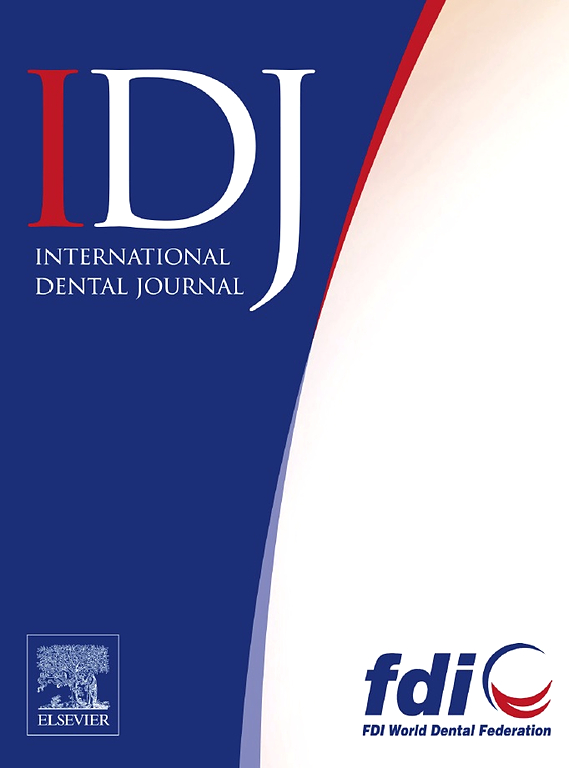不同牙种植体连接体设计的生物力学分析:数值有限元研究
IF 3.2
3区 医学
Q1 DENTISTRY, ORAL SURGERY & MEDICINE
引用次数: 0
摘要
目的应用有限元法评价5种常用种植/基台连接物的生物力学性能。方法采用计算机辅助设计(CAD)软件设计种植体-基台连接的五种模型:三通道(M1)、锥形内六边形(M2)、莫尔斯锥带一体化螺钉(M3)、内六边形(M4)和管中管(M5)。骨模型为同轴圆柱体,内圆柱体为海绵状骨,外圆柱体为1 mm厚的皮质骨。在基牙上设计一个40 μ m厚的水泥层的前磨牙冠几何形状。每个模型应用了三种加载场景:(1)100 N的压缩载荷,(2)50 N的45°斜载荷(相对于种植体轴),以及(3)50 N的侧向载荷。结果所有应力和变形值均在所用材料的允许范围内。值得注意的是,M1、M4和M5表现出最佳的生物力学性能。M1和M4的种植体部件的应力最低,在压缩条件下,基台的应力为24.4 ~ 24.8 MPa,螺钉的应力为27.5 ~ 27.9 MPa,冠变形最小(8.6µm, M3为11.7µm)。相比之下,M3的种植体构件应力最高(基牙68.5 MPa,螺钉120.2 MPa),但皮质骨应力最低,为7.7 MPa, M4为10.2 MPa。结论内六边形(M4)或三通道(M1)设计的种植体更适合长期使用,因为它们可以最大限度地减少种植体内部的应力和变形,从而降低假体失效的风险。虽然莫尔斯锥度(M3)设计可能有利于骨密度受损的患者,但其较高的种植体组件应力需要谨慎。临床意义本研究为支持种植体-基台连接设计的循证选择提供了有价值的见解。在5种评估系统中,三通道(M1)和内六边形(M4)设计通过最大限度地减少种植体组件和周围骨内的应力集中,表现出优越的生物力学性能。因此,推荐常规临床使用这些配置,以增强假体的稳定性,减少螺钉松动或骨折等机械并发症的可能性,并延长假体的使用寿命。相反,尽管带有集成螺钉的莫尔斯锥(M3)设计对皮质骨的应力最低,这表明对骨质量降低的患者有潜在的益处,但它在种植体部件内显示出最高的应力水平,表明更高的机械故障风险。临床医生在计划治疗时应权衡这些生物力学方面的权衡,特别是在高功能负荷或骨骼状况受损的患者中。本文章由计算机程序翻译,如有差异,请以英文原文为准。
Biomechanical Analysis of Various Connector Designs of Dental Implant Complex: A Numerical Finite Element Study
Objective
To evaluate the biomechanical behavior of 5 types of commonly used implant/abutment connectors, using Finite Element Methods (FEM).
Methods
Five models of implant-abutment connections were designed using computer-aided design (CAD) software: Tri-channel (M1), Conical internal hexagon (M2), Morse taper with an integrated screw (M3), Internal hexagon (M4), and Tube-in-tube (M5). The bone was modeled as coaxial cylinders, with the inner cylinder representing spongy bone and the outer 1 mm-thick cylinder representing cortical bone. A premolar crown geometry was designed onto the abutment with a 40 µm-thick cement layer. Three loading scenarios were applied to each model: (1) a 100 N compressive load, (2) a 50 N oblique load at 45° (relative to the implant axis), and (3) a 50 N lateral load.
Results
All stress and deformation values remain within the tolerable limits for the materials used. Notably, M1, M4, and M5 exhibited optimal biomechanical performance. M1 and M4 recorded the lowest stresses in implant components, 24.4 to 24.8 MPa in the abutment and 27.5 to 27.9 MPa in the screw under compression, along with minimal crown deformation (8.6 µm compared to M3’s 11.7 µm). In contrast, M3 experienced the highest implant-component stresses (68.5 MPa in the abutment and 120.2 MPa in the screw) but showed the lowest cortical bone stress at 7.7 MPa, versus 10.2 MPa in M4.
Conclusion
For long-term durability, implants with an internal hexagon (M4) or tri-channel (M1) design are preferable, as they minimize stress and deformation within the implant complex, thereby reducing the risk of prosthetic failure. While the Morse taper (M3) design may benefit patients with compromised bone density, its higher implant-component stresses warrant caution.
Clinical significance
This study provides valuable insights to support evidence-based selection of implant–abutment connection designs. Among the 5 evaluated systems, the Tri-channel (M1) and Internal Hexagon (M4) designs demonstrated superior biomechanical performance by minimizing stress concentrations within the implant components and surrounding bone. These configurations are therefore recommended for routine clinical use to enhance prosthetic stability, reduce the likelihood of mechanical complications such as screw loosening or fracture, and prolong implant longevity. Conversely, although the Morse Taper with integrated screw (M3) design showed the lowest stress on cortical bone – suggesting potential benefit for patients with reduced bone quality – it exhibited the highest stress levels within implant components, indicating a higher mechanical failure risk. Clinicians should weigh these biomechanical trade-offs when planning treatment, particularly in patients with high functional loads or compromised bone conditions.
求助全文
通过发布文献求助,成功后即可免费获取论文全文。
去求助
来源期刊

International dental journal
医学-牙科与口腔外科
CiteScore
4.80
自引率
6.10%
发文量
159
审稿时长
63 days
期刊介绍:
The International Dental Journal features peer-reviewed, scientific articles relevant to international oral health issues, as well as practical, informative articles aimed at clinicians.
 求助内容:
求助内容: 应助结果提醒方式:
应助结果提醒方式:


